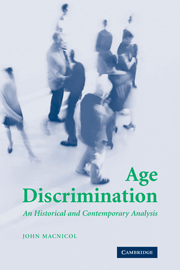Book contents
- Frontmatter
- Contents
- List of figures
- List of tables
- Acknowledgements
- Part I Ageism and Age Discrimination
- 1 Analysing ageism and age discrimination
- 2 Justice between generations
- Part II The Current Revival of Interest in Britain
- Part III Retirement, health status and work-disability
- Part IV America's Age Discrimination in Employment Act
- Bibliography
- Index
1 - Analysing ageism and age discrimination
Published online by Cambridge University Press: 24 August 2009
- Frontmatter
- Contents
- List of figures
- List of tables
- Acknowledgements
- Part I Ageism and Age Discrimination
- 1 Analysing ageism and age discrimination
- 2 Justice between generations
- Part II The Current Revival of Interest in Britain
- Part III Retirement, health status and work-disability
- Part IV America's Age Discrimination in Employment Act
- Bibliography
- Index
Summary
Introduction: the importance of age
At every stage in our lives, we are confronted by the inevitability of our own ageing. As we progress through the ‘journey of life’, we are acutely conscious of the ageing process as it affects our bodies, our attitudes, the environment we create for ourselves and our interactions with other people of different ages. In personal relationships, we tend to choose friends and partners from those proximate in age – most ‘lonely hearts’ advertisements stipulate age – and the fact is that most people are still fascinated or even horrified by intimate relationships that span wide age-gaps: Joan Collins's marriage in early 2002, to a man thirty-three years her junior, was newsworthy precisely because it broke such unwritten, but powerful, rules. Most of us are intensely aware of the precise social demarcations based upon age, and feel uncomfortable if we stray into an age-inappropriate social setting (a nightclub for the twenty-somethings on the one hand, a summer evening game of bowls on the other). Our everyday social judgements are frequently age-based, even if we consciously deny it: for example, most of us, on meeting a new person, will try to guess their age and will make assumptions about them as a result.
Explaining the collective behaviour and social characteristics of a population sub-group by reference to its average age is still relatively uncommon, perhaps because social scientists are wary of age stereotyping, demographic determinism and gerontophobia: the idea that ageing societies are inevitably societies in decline – with diminishing stocks of collective energy, enterprise and innovation – has a long and undistinguished pedigree, going back at least to the 1930s.
- Type
- Chapter
- Information
- Age DiscriminationAn Historical and Contemporary Analysis, pp. 3 - 47Publisher: Cambridge University PressPrint publication year: 2006
- 2
- Cited by



